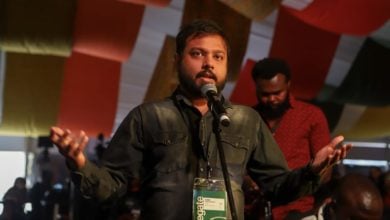Recent economic statistics reveal an undeniable pattern of the U.S. working class suffering an erosion of its standards of living. Taken one at a time, each of these statistics could be a shocking snapshot of our society; they could each be considered unjust. But if you put all these snapshots together, you get something more than a picture; you see a whole story unfolding, a process of long-term decline for U.S. workers. These include:
- 61 percent of Americans “always or usually” live paycheck to paycheck, up from 49 percent in 2008 and 43 percent in 2007;
- The bottom 50 percent of income earners in the United States now collectively own less than 1 percent of the nation’s wealth;
- 24 percent of American workers say that they have postponed their planned retirement age in the past year;
- Only the top 5 percent of U.S. households have earned enough additional income to match the rise in housing costs since 1975;
- More than 40 percent of workers are now in service jobs, which are often very low paying;
- For the first time in U.S. history, more than 40 million Americans are on food stamps, and the U.S. Department of Agriculture projects that number to go up to 43 million in 2011;
- Approximately 21 percent of all children in the United States are living below the poverty line in 2010—the highest rate in 20 years.
The United States was founded as a colonial settlement that expanded and waged war on Indigenous peoples to acquire land, and then brought over millions of Africans in chains to work that land. It was founded primarily by the use of force. But beyond force, the country also has a founding idea—or what could be better called a founding myth—the idea that “anyone can make it.”
The country’s founding myth
The Declaration of Independence states “that all men are created equal, that they are endowed by their Creator with certain unalienable Rights, that among these are Life, Liberty and the pursuit of Happiness.” It was a last-second revision that made the phrase come out like that; initially it read “life, liberty and property.” The idea was that everyone had a natural right to work hard and acquire property; that without property you could never really be free, independent or happy.
This myth had some basis for white men. In most of Europe, centuries of feudalism and the beginnings of capitalist agriculture left little unclaimed and available land. Small farmers were pushed off their land by big landowners. While major class confrontations over land also took place in America, it was, by contrast, a land of opportunity where a much higher proportion of white men—the only ones qualified for citizenship—could actually own a small farm and possess property.
The myth of the United States was that the opportunities and availability of property meant that this country did not have permanent social classes as in Europe. If sharp distinctions did develop between rich and poor, these distinctions reflected the natural abilities of the individual.
Of course this myth conveniently overlooked that in much of the country it was the hard, unpaid work of slaves that made property and prosperity possible for white men who previously had little. Likewise, the opportunities to pack up and move West—which remained possible from early settlement until the late 19th century—were created at the expense of the continent’s Indigenous peoples.
Those times are long gone, but these founding myths have been sustained decade after decade. We have been taught through the media, pop culture and the school system that this is still the country where “anyone can make it.” We are still supposed to celebrate and worship the rich for their accomplishments. We are told they deserve every penny, while poor people lack drive, ambition or “personal responsibility.”
The practices of imperialism also created a material basis for the belief that “anyone can make it.” The super-exploitation and extreme impoverishment of the workers and peasants of Asia, Africa, Latin America, Eastern Europe and the Middle East, in addition to the technological and financial domination of the colonizing countries, made possible a rise in living standards.
Then, after World War II, when the U.S. government faced the competition of the Soviet Union and its expansive social safety net, the labor movement was strong and the country’s industrial production was unrivaled. The government initiated programs that fostered the concept of the middle class such as low-interest loans for workers to become homeowners and send their children to college.
The “white collar” sector of office workers, educators, administrators and salespersons expanded in the 1950s and 1960s when U.S. imperialism developed a dominant position in the global economy and world finance. Many of these “professionals” had parents who had worked in grueling conditions in factories, but they could look back and say: “Look how far I have come.”
These developments fed the belief that better-paid workers could succeed in the system—that they are, in fact, not workers at all, but “middle class.” This ideology, with all its inherent prejudices, has been particularly strong among relatively privileged sectors of white workers who could access jobs, programs and services denied to African Americans and other people of color.
The “race to the bottom”
But now, during a deep economic crisis, it is precisely these middle sectors that are realizing how little they have: how the banks really own “their” homes, how their 401(k) retirement plans add up to very little, how the moment they lose their jobs everything else will crumble, how paying college tuition can wipe out life savings and create huge debts, how a medical emergency can sink them into bankruptcy.
As the living standard of this sector has plummeted, they have begun to question the established politicians and many have become more open to a radical critique. The Occupy Wall Street movement is a sign of this.
On the other side, as the Tea Party has shown, the unraveling “middle class” can also be pulled into a reactionary, racist direction. This is what right-wing sectors of the ruling class will use to deflect attention away from themselves and the contradictions inherent in capitalism. They point to immigrants, talk about high taxes and promote a racist image of Black “welfare mothers” so as to target the most vulnerable sectors and play on this country’s long-established racist traditions.
While the erosion of “middle class” living standards highlights the country’s real class divisions, building a working-class fight back is not an automatic process. The PSL exists to help working people of all backgrounds see that socialism is the only answer to capitalism’s “race to the bottom.”






